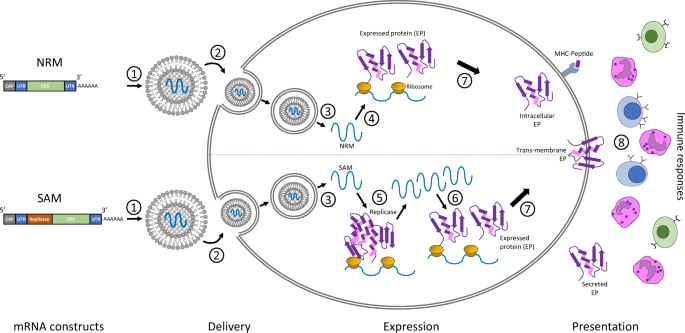2. What about any side effects that are concerning? How common are these in such vaccine trials?
In the latest development, researchers at the Massachusetts General Hospital have identified some markers that may predict coagulation assisted complications in patients with COVID-19 (
4). The risks for an mRNA based vaccine come with its own flavors besides other usual ones typically associated with vaccine trials. How significantly would they pan out as compared to other types of vaccine systems, remains yet to be seen.
According to the Moderna company’s website (
5), their mRNA-1273 vaccine is against the stabilized form of Spike protein (S). Though this portion has remained fairly stable small variants have observed (
6). Also, the vaccine is under the assumption that the molecular pathogenesis is from this protein alone. The virus is fast evolving.
Also, the progression through different phases has been greatly accelerated so far, given the nature of the pandemic. As a result, many approval steps may have had to be rushed through, for expediency; one may have to assume that all these steps must have been duly vetted out as well.
3. What makes up for a very promising vaccine trial and convince someone to sign up for this trial vs. other vaccine trials?
The website of the company should have a clear and transparent timeline of the progress of the vaccine development so far; starting from their initial procurement of the sequence data and the contract date till today. It would be therefore possible to get an idea of the way in which the results are going to pan out, assuming the site continues to keep it that way (
7).
4. What is the ideal sample size for a Phase 3 study of such a vaccine trial? Can numbers alone suffice?
A couple of recent ongoing trials (
8,
9) have decided to enroll about 30,000 for their Phase 3 of clinical trials, and this is a fairly good enough for a phase trial of this size. Most of such trials run into few thousand anyway. The greater question should be if there is time enough for follow up studies to study the efficacy and safety (
10) and observe for any adverse events. Given the current nature of the pandemic that again may have to be ‘accelerated’. How that may pan out to assuage the concerns of the public before public release is a different matter.
5. What does this Phase 3 study need to prove that it is a good vaccine?
Firstly, the vaccine has to be shown to be widely effective, matching up with beyond the success rates of the other vaccine trials. In addition to this, adverse events must be very insignificant in comparison to the rates for other vaccine therapies. All of these results must be publicly available and transparent, of course.
6. What is ‘vaccine efficacy’ and how would a ‘50% effective’ vaccine match up to one that is 70% effective? Can we expect one that is 70% or more effective?
An informal search on the web shows any trial success above 50% is good enough, 60% would really pushing it. I am not aware of 70% success rates, great if it does. A recent study by researchers from MIT looked into the success rates of Vaccine trials vs therapeutic trials and found that they were more likely to hit the dust than their non-vaccine counterparts BUT that reason has been mainly attributed to lack of investment and efforts, in the recent decades, in finding the ideal approaches to delivering vaccines effectively (
11,
12).
Numbers aside, at this point the aim should be mainly to increase the absolute numbers who are successfully immunized and can thus add up to the herd immunity.
Also, this being an mRNA vaccine, the first of its kind in a worldwide major trial, is likely to be recorded in itself. Given the theory behind the vaccine, the success rate can be expected to be pretty high like its other counterparts.
7. What about some common fears, misconceptions, or misplaced logic?
Despite the year being 2020, the fears and myths against vaccines have grown so exponentially in the last few years that one would wonder … Well! There are any number of myths and all of them debunked as well.
One of such misplaced logic, of particular relevance to the current pandemic, is "allowing herd immunity to do its job"! This is another way to skip vaccines under some pretext at a great cost to public health. To put it simply, it sounds like a game of Life-roulette. Consider this! We have witnessed 200 thousand deaths in a matter of months and still counting!!! The US has probably never seen anything like this. As if gambling with one’s life were not enough you are just endangering everyone out there. There are countless instances of people resorting to such an approach and regretting it badly. Not worth it! On the other hand, there are nations that have successfully taken active measures in this regard. One should learn from them and allow Science to do its job.
8. Why is it important to volunteer? How to allay fears of the risks?
The success of a clinical trial exclusively depends on the active participation of healthy volunteers. Consider this! If you can get a thrill out a rollercoaster OR bungee jump then this is far better; you become a hero helping science advance further for public health. In an open and transparent setting of a clinical trial, the volunteer will and should have access to all that entails the participation.
